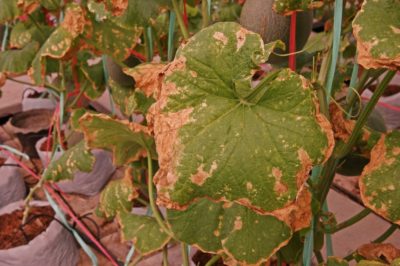Blight Diseases
Three fungal blight diseases strike cukes in warm, rainy, windy weather. Splashing water carries their spores to cucumber leaves. They are:
- Gummy stem blight threatens cukes of stages. Young seedlings develop brown leaf spots. Mature leaves display yellowed edges and brown spots. Infected fruit oozes sticky black liquid from mushy lesions.
- Phythophora blight wilts cukes from their bases to the tips of their branches, even though their foliage stays green. Eventually, they turn mushy and brown at the soil line, as white mold and soft wet spots cover their fruit.
- Cukes with brown, yellow-bordered leaf spots have early Alternaria leaf spot. This blight browns, withers and kills the leaves.
Managing Blight
Remove and destroy affected cukes. To prevent an outbreak, spray with organic liquid copper as soon as rain is forecast, and every 10 days until dry conditions return. Clear all plant debris and spread 2 inches of organic mulch around the cukes to stop spores from hitting their leaves.
Bacterial Wilt
Wilted cuke leaves that don’t recover at night are a symptom of bacterial wilt disease. To confirm an infection:
- Cut through a wilting cuke at the base of a vine.
- Rub the cut edges together.
- Pull them apart. If they ooze sticky threads, wilt is the problem and the plant can’t be saved.
Preventing Bacterial Wilt
Cukes contract this disease from cucumber beetles. To keep your plants wilt-free, drape the cuke bed them with permeable row covers at planting. They’ll stop the bugs but let air, sun and water reach the cukes.
Powdery Mildew
Cuke leaves sporting patches of powdery white mold suffer from powdery mildew. This fungal disease strikes in warm, humid weather with temperatures between 60°F and 80°F (15.5°C and 26.6°C). A severe infection can be lethal.
Managing Powdery Mildew
For organic powdery mildew control, mix 4 teaspoons (23.7 ml) of baking soda and several drops of non-detergent liquid soap in 1 gallon (3.78 liters) of water. Spray until the solution drips from both sides of the leaves. Apply every two days until the problem subsides.
